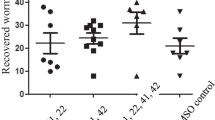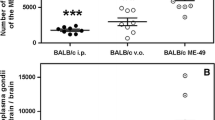Abstract
The new bacteriocidal drug epiroprim (Ro-11-8958) was tested (alone or in combination with dapsone) on its efficacy againstToxoplasma gondii andPneumocystis carinii in their hosts: laboratory mice and/or nude mice/rats, and was compared to the curative effects of the recent drugs of choice. The experiments clearly pointed out that epiroprim has significant effects on the reduction of both parasites when given alone. In combination with dapsone epiroprim led to a complete cure of toxoplasmosis in mice. This finding is of some importance for AIDS patients mostly suffering from bacteriosis and parasitosis at the same time.
Similar content being viewed by others
References
Dietrich M (1989) DiePneumocystis carinii-Pneumonie. Klinik, Diagnostik, Therapie, Prophylaxe. Springer, Berlin Heidelberg
Enzensberger W, Helm EB, Fisher PA, Stille W (1985) Toxoplasmosis of the CNS: an important neurological complication of AIDS. Trop Med Parasitol 36 [Suppl II]: 19
Feinberg J, Hoth DF Jr (1992) Current status of HIV therapy. II. Opportunistic diseases. Hosp Pract [off] 27: 161–174
Frenkel JK (1988) Important pathologic effects of parasitic infections of man. In: Mehlhorn H (ed) Parasitology in focus. Springer, Berlin Heidelberg New York, pp 538–590
Hardy WD (1991) Recent advances and future strategies for prophylaxis of AIDS related opportunistic infections. In: Krown SE, Borden EC (eds) Current issues in the management of patients with HIV-infection. Mediscript, London, pp 43–77
Hardy WD, Feinberg J, Finkelstein DM, Power ME, He W, Kaczka C, Frame PT, Holmes M, Waskin H, Fass RJ, Powderly WG, Steigbigel RT, Zuger A, Holzman RS (1992) A controlled trial of trimethoprim/sulfamethoxazole or aerosolized pentamidine for secondary prophylaxis ofPneumocystis carinii pneumonia in patients with the acquired immunodeficiency syndrome. N Engl J Med 327: 1842–1846
Hartman P, Then RL (1994) Folic acid biosynthesis inhibitors as agents against multiple opportunistic pathogens: the potential of epiroprim (abstract 382). Proceedings, 33rd meeting of the ICAAC, New Orleans, ASM Press 1993, p 189
Heald A, Flepp M, Chave JP, Malinverni R, Rüttiman S, Gabriel V, Renold C, Sugar A, Hirstal B, the Swiss Cohort Study Group (1994) Treatment for cerebral toxoplasmosis protects againstPneumocystis carinii pneumonia in patients with AIDS. Ann Intern Med 115: 760–770
Leoung GS, Miles J, Hopewell PC, Hughes W, Wofsy C (1986) Dapsone-trimethoprim forPneumocystis carinii pneumonia in the acquired immunodeficiency syndrome. Ann Intern Med 105: 45–55
Leport C, Raffi F, Matheron S, Katlama C, Regnier B, Saimot AG, Marche C, Vedrenne C, Vilde JL (1988) Treatment of central nervous system toxoplasmosis with pyrimethamine/sulfadiazine combination in 35 patients with AIDS. Am J Med 84: 94–98
Mackenstedt U, Ungar C, Sahm M, Seitz HM, Mehlhorn H (1994) New aspects in the life cycle ofPneumocystis carinii, revealed by DNA measurements. J Eur Protistol (in press)
Markell EK, Voge M, John DT (1992) Medical parasitology WB Saunders, Philadelphia London
Mehlhorn H, Eichenlaub D, Löscher T, Peters W (1995) Diagnostik und Therapie der Parasitosen des Menschen, 2nd edn. G Fischer, Stuttgart New York
Pearson RD, Hewlett EL (1987) Use of pyrimethamine sulfadoxine (Fansidar) in prophylaxis against chloroquine resistantPlasmodium falciparum andPneumocystis carinii. Ann Intern Med 106: 714–724
Raether W (1988) Chemotherapy and other control measures of parasitic diseases in domestic animals and man. In: Mehlhorn H (ed) Parasitology in focus. Springer, Berlin Heidelberg New York, pp 739–866
Remington JS, Desmonts G (1989) Toxoplasmosis. In: Remington JS, Klein JO (eds) Infectious diseases of the fetus and newborn infant. W.B. Saunders. Philadelphia, pp 89–119
Seitz HM, Kersting G (1985)Toxoplasma infection in AIDS patients. Trop Med Parasitol 36: 15–16
Then RL, Angehrn P, Cullmann W, Hartman P (1994a) Properties of epiroprim (Ro-11-8958) as an antibacterial agent (abstract 383): Proceedings, 33rd meeting of the ICAAC, New Orleans, ASM Press 1993, p 189
Then RL, Hartman P, Kompis I, Stephan-Güldner M, Stöckel K (1994b) Epiroprim. Drugs of the Future 19: 446–449
Walzer PD, Foy J, Steele P, White M (1994) Effectiveness of Ro-11-8958 (Epiroprim, EPM) and other dihydrofolate reductase (DHFR) inhibitors in the therapy of experimentalPneumocystis carinii pneumonia (abstract 385). Proceedings, 33rd meeting of the ICAAC New Orleans, ASM Press 1993, p 189
Author information
Authors and Affiliations
Rights and permissions
About this article
Cite this article
Mehlhorn, H., Dankert, W., Hartman, P.G. et al. A pilot study on the efficacy of epiroprim against developmental stages ofToxoplasma gondii andPneumocystis carinii in animal models. Parasitol Res 81, 296–301 (1995). https://doi.org/10.1007/BF00931533
Received:
Accepted:
Issue Date:
DOI: https://doi.org/10.1007/BF00931533




